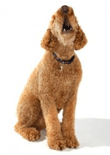
Stranger Danger: Advice on How to Train Your Dog
By Sally Gutteridge | Posts , Training
 Many parks and recreation grounds have their particular group. The same group of people that wander around daily together whilst their lucky dogs run and socialize together, the dogs and people become friends and everyone wins.
Many parks and recreation grounds have their particular group. The same group of people that wander around daily together whilst their lucky dogs run and socialize together, the dogs and people become friends and everyone wins.
Unfortunately in many parks there is also often the dangerous stranger. The regular walker who fancies himself (or herself) as the next charismatic well marketed celebrity dog trainer. Usually this individual is seen as somewhat of a nuisance; particularly to people that know the fundamentals of positive dog training. Unsolicited dog training advice is inconvenient, often incorrect and sometimes dangerous.
As new and naive dog owners, we are often pleased to receive any advice given with the aim of improving our dogs behavior. There are risks however involved with accepting and acting upon random advice. After all we wouldn’t accept advice on bringing up our children from strangers so why how to train your dog.
There are many dog training methods floating around in the average dog walking area. These range from hitting your dog with a rolled up newspaper to flicking your heel behind you to kick a poor unsuspecting dog. The kicking is a theory I have recently heard on how to train your dog to walk at heel. How the poor creature is supposed to make that connection is beyond me.
It is usual to hear the term “dominant” and “submissive” whilst out walking too. These terms are overused and often offered as an inaccurate description of whatever some poor dog has decided to do at the time of observation. Often these terms are also accompanied by a statement that an owner has to “be the boss” or “show the dog who is in charge”.
Show him whose boss!
Dominance is an unproven theory on how to train your dog, often and unfortunately this theory can also be quite unkind to dogs. Unsurprising for it is dog training based on a belief that the dog is always looking out for a way to take over the household.
Based on studies on behavior within wolf packs, the dominance theory advocates that every unhelpful dog behavior means that he is trying to occupy the position of leader within the “pack”. So when your dog pulls on the leash he is trying to physically lead, when he stares at your food he is not respecting your leadership, and when he jumps up he is trying to get close to your face to establish dominance.
Theories that aim to show you how to train your dog by dominance range from pretending to eat from the dogs bowl to lying in the dog bed.
Many spin off dog training techniques have appeared loosely based on the theory of dominance. Leadership and being the boss are two of them. Unfortunately for the poor dog’s any advice on establishing dominance often involves physical and/or psychological harm. The alpha roll being one of them, the owner is encouraged to roll a dog on its back to establish dominance. So a confused dog, confronted and rolled over by a misinformed owner is the result.
The truth
The truth behind this theory is that dogs do not want to rule. They do not look for weakness in their human being in order to attempt world domination. Training by trying to keep a dominant role is ridiculous. The dog will not understand what you are doing. You would be speaking to your dog in a language even further removed that the species distance between you and him already. If anyone offers you advice on how to train your dog involving any kind of dominance theory or showing him his place, please for your own and your dog’s sake walk away.
The only way to understand your dog is to accept that he learns by reinforcement from you, the people around you and his environment. If you reward helpful behavior then you are teaching him to repeat it. Similarly if you reward unhelpful behavior he will also repeat it, because he has learned that it is beneficial to him. Put some time into learning how to train your dog with kindness and positive reinforcement. Work out which behavior you may be keeping active by an inadvertent reward such as attention. Work with your dog, not against him with understanding and a mutual respect.


 It is a term often used, dog whisperer. Giving the impression that communication with a canine is something of a rare achievement. A basic internet search will provide one with plentiful dog expert’s that offer advice and label themselves a dog whisperer.
It is a term often used, dog whisperer. Giving the impression that communication with a canine is something of a rare achievement. A basic internet search will provide one with plentiful dog expert’s that offer advice and label themselves a dog whisperer.
 The golden retriever is a nice dog to raise and train. Resembling a bear cub as a puppy the retriever will grow into a loyal and humorous companion with stunning looks. This breed of dog is rarely complicated and usually responds well to praise and food reward. Originally bred to retrieve game birds and waterfowl the retriever is often seen proudly, yet gently, carrying a toy or shoe.
The golden retriever is a nice dog to raise and train. Resembling a bear cub as a puppy the retriever will grow into a loyal and humorous companion with stunning looks. This breed of dog is rarely complicated and usually responds well to praise and food reward. Originally bred to retrieve game birds and waterfowl the retriever is often seen proudly, yet gently, carrying a toy or shoe.
 The owner of a new puppy has an almost blank canvas. A dog learns from the moment it is born and all of a puppy’s experiences determine how it will be as an older dog.
The owner of a new puppy has an almost blank canvas. A dog learns from the moment it is born and all of a puppy’s experiences determine how it will be as an older dog.
 Playing with your dog will build the relationship between you. It will use his mind in order to enable him to settle when you need him to, and an enthusiastic game will certainly be fun for both of you. The home that hosts multi dogs automatically provides stimulation for the animals by allowing interaction with each other. Single dogs benefit greatly from the interaction and stimulation they get when you play with your dog.
Playing with your dog will build the relationship between you. It will use his mind in order to enable him to settle when you need him to, and an enthusiastic game will certainly be fun for both of you. The home that hosts multi dogs automatically provides stimulation for the animals by allowing interaction with each other. Single dogs benefit greatly from the interaction and stimulation they get when you play with your dog.
 The bang trick is great fun to watch and perform. A dog that is taught properly to respond to “Bang” as a command word will drop to the ground, when shot with a gun created from his handlers fingers, and stay perfectly still until a release cue is given.
The bang trick is great fun to watch and perform. A dog that is taught properly to respond to “Bang” as a command word will drop to the ground, when shot with a gun created from his handlers fingers, and stay perfectly still until a release cue is given.
 Dog training commands are widespread and varied. The humble and loyal canine is employed within so many roles that the list of dog training commands is getting lengthier all the time.
Dog training commands are widespread and varied. The humble and loyal canine is employed within so many roles that the list of dog training commands is getting lengthier all the time.
 As a new dog owner it is perfectly normal to see your recent addition to the family as a complete mystery. Particularly with so much, and often conflicting, dog training advice available.
As a new dog owner it is perfectly normal to see your recent addition to the family as a complete mystery. Particularly with so much, and often conflicting, dog training advice available.
 An incessant barking dog is sufficient to drive the most patient and loving dog owner slightly mad. The most tempting thing to do in this circumstance is to shout at the excited dog to stop. By doing this though you are only getting the dog more excited. In many cases he will believe that you are joining in and bark louder still.
An incessant barking dog is sufficient to drive the most patient and loving dog owner slightly mad. The most tempting thing to do in this circumstance is to shout at the excited dog to stop. By doing this though you are only getting the dog more excited. In many cases he will believe that you are joining in and bark louder still.
 Recall training with your dog is crucial. The majority of dogs need to be able to run free to use up their energies on a daily basis. If your dog will not come back when called, then exercise can become a worrying and frustrating time.
Recall training with your dog is crucial. The majority of dogs need to be able to run free to use up their energies on a daily basis. If your dog will not come back when called, then exercise can become a worrying and frustrating time.